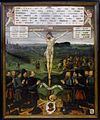Memorial stone for Blasius Hochgrewe
The memorial stone for Blasius Hochgrewe from the second half of the 16th century is one of the oldest surviving monuments in the Estonian capital Tallinn (German Reval ).
background
On September 11, 1560, two skirmishes between Russian troops under the command of Tsar Ivan IV and a Tallinn vigilante took place in the first phase of the Livonian War (1558–1561) at the gates of Tallinn .
The Tallinn population was able to muster around 250 horsemen and 500 infantry to oppose the Russians. These included nobles from Toompea , lords and councilors, members of the brotherhood of blackheads, as well as ordinary citizens and serfs.
The Tallinn troops were able to repel the Russian soldiers on the so-called Jerusalem Mountain and thus prevent a siege of the city. The enemy army then pillaged the surrounding villages and withdrew in the direction of Paide .
Sixty residents of Tallinn were probably killed in the two clashes outside the walls of Tallinn. These included nobles, large merchants and ten members of the Brotherhood of Blackheads. The brothers' names are immortalized on an oil painting from 1561 that is now in the Tallinn City Museum. The epitaph is probably authored by the painter Lambert Glandorp , a member of the Great Guild .
Thinking stone
One of the dead on September 11, 1560 was the Tallinn merchant Blasius Hochgrewe. In today's Kitseküla district , on Marta Street (Marta tänav), there is a memorial stone from that time, which has been preserved to this day.
A stone cross 2.8 meters high and up to 1.5 meters wide rises above a square pedestal that was erected at the end of the 19th century. On its south-facing side is the inscription in Low German :
- Anno 1560 the 11th of September ys here here Blasius Hochgreve vom Rüssen mercifully succumbed to God sy eme graciously and vorlene em the youngest dage eyne vrolike superstandinge thom eternal levende. Amen.
On the reverse is a crucifix with a portrait of the fallen man at the feet. He is shown kneeling in armor . A helmet stands in front of him. To the left of the trunk of the cross, his coat of arms used to be attached.
The monument has been a listed building since 1964. It's in bad shape today. A modern plaque on the pedestal reminds of what is happening.
photos
literature
- Eugen von Nottbeck, Wilhelm Neumann: History and art monuments of the city of Reval . Volume two: The city's art monuments. Tallinn 1904. pp. 208f.
Web links
- Entry in the Estonian Monument Protection Register
Individual evidence
- ^ Tallinn's Oldest Monument - The Memorial Cross of Blasius Hochgrewe , accessed on October 31, 2018.
- ^ In: Johann Christoph Brotze : Collection of various Liefländischer monuments, prospects and the like






